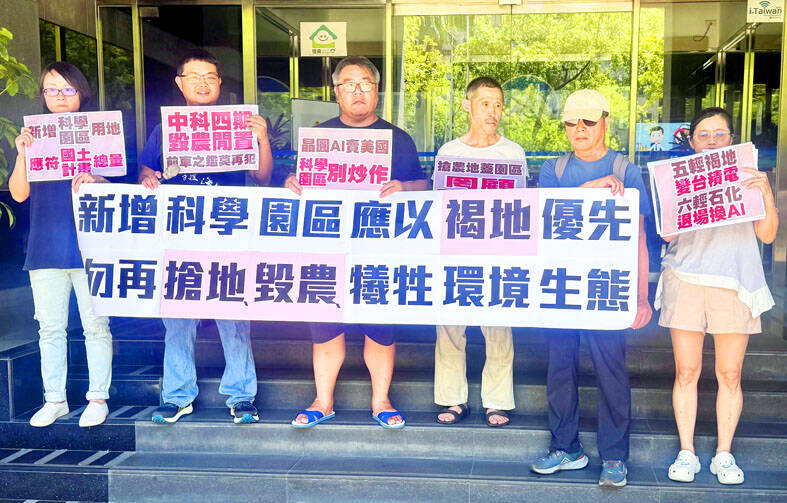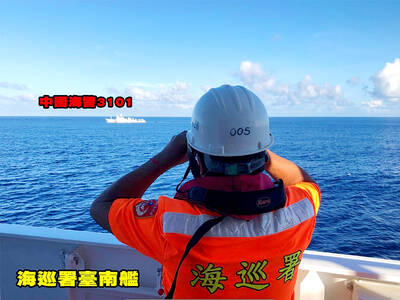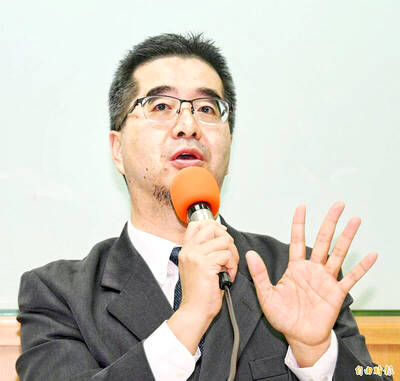National spatial planning should not be reduced to a supportive scheme to land development policies, environmental groups told a news conference yesterday, urging the government to prioritize brownfield instead of farmland in constructing new scientific parks.
The National Science and Technology Council (NSTC) — then the Ministry of Science and Technology — designated an additional 1,000 hectares of land for scientific park use when the Executive Yuan approved the National Spatial Plan in 2018.
The effort was continued in a strategic environmental assessment (SEA) report of scientific park development initiatives proposed by the NSTC in May based on the Taoyuan-Hsinchu-Miaoli Great Silicon Valley Plan and the Greater Southern New Silicon Valley Promotion Plan, with 2,000 hectares more to be added by 2050.

Photo: Huang Yi-ching, Taipei Times
The 1,000 hectares to be allocated by 2036 — which would increase the total scientific park land use to 5,440 hectares — might not be sufficient for actual industrial demand, given that current land for scientific park use, either in operation or under planning or development, has reached 5,341 hectares nationwide, the report said.
Therefore, 2,000 hectares more are required to boost the total area to 7,440 hectares to maintain Taiwan’s leading status in the global semiconductors and artificial intelligence sectors by providing enough land for new plants, it said.
Government Watch Alliance chief executive officer Hsu Hsin-hsin (許心欣) said the land chosen for the two “Silicon Valley” plans does not accord with local land use zoning in each administrative area.
The NSTC should not encroach on farmland for scientific park development in breach of the National Spatial Plan, she said.
Hsu cited Central Taiwan Science Park’s (CTSP) Erlin Science Park as an example, saying that agricultural workers were forced to leave the region when the government expropriated more than 600 hectares of farmland to build the park.
However, the science park has been left unused with few companies moving in, she said.
Hsu cited Taiwan Hsinchu Foundation chairman Sam Lin (林聖崇) as saying that brownfield — polluted land — should be prioritized in scientific park land use.
For example, Taiwan Semiconductor Manufacturing Co has set up new plants at CPC Corp, Taiwan’s polluted plant sites in Kaohsiung’s Houjin (後勁) areas, Lin was cited as saying.
Eyes on Pollution of CTSP secretary-general Hsu Wan-ling (徐宛鈴) said the newly proposed land addition should adhere to national spatial planning.
She also cited the National Land Management Agency as saying at the previous environmental impact assessment (EIA) meeting that “national spatial planning would be adjusted based on SEA conclusions.”
National spatial planning should not be reduced to supportive schemes for the Executive Yuan’s or the NSTC’s policies, Hsu Wan-ling said.
The NSTC yesterday said that allocating more land for potential industrial demand is necessary to retain high-tech industries and relevant investments in Taiwan.
The proposal is at its preliminary stage and further environmental impact assessments, as well as prior communications with local stakeholders, would be conducted for each scientific park construction project, it said.
The EIA committee yesterday at a meeting requested that the use of polluted land be prioritized in future scientific park developments.

The Coast Guard Administration (CGA) yesterday said it had deployed patrol vessels to expel a China Coast Guard ship and a Chinese fishing boat near Pratas Island (Dongsha Island, 東沙群島) in the South China Sea. The China Coast Guard vessel was 28 nautical miles (52km) northeast of Pratas at 6:15am on Thursday, approaching the island’s restricted waters, which extend 24 nautical miles from its shoreline, the CGA’s Dongsha-Nansha Branch said in a statement. The Tainan, a 2,000-tonne cutter, was deployed by the CGA to shadow the Chinese ship, which left the area at 2:39pm on Friday, the statement said. At 6:31pm on Friday,

The Chinese People’s Liberation Army Navy’s (PLAN) third aircraft carrier, the Fujian, would pose a steep challenge to Taiwan’s ability to defend itself against a full-scale invasion, a defense expert said yesterday. Institute of National Defense and Security Research analyst Chieh Chung (揭仲) made the comment hours after the PLAN confirmed the carrier recently passed through the Taiwan Strait to conduct “scientific research tests and training missions” in the South China Sea. China has two carriers in operation — the Liaoning and the Shandong — with the Fujian undergoing sea trials. Although the PLAN needs time to train the Fujian’s air wing and

Taiwanese celebrities Hank Chen (陳漢典) and Lulu Huang (黃路梓茵) announced yesterday that they are planning to marry. Huang announced and posted photos of their engagement to her social media pages yesterday morning, joking that the pair were not just doing marketing for a new show, but “really getting married.” “We’ve decided to spend all of our future happy and hilarious moments together,” she wrote. The announcement, which was later confirmed by the talent agency they share, appeared to come as a surprise even to those around them, with veteran TV host Jacky Wu (吳宗憲) saying he was “totally taken aback” by the news. Huang,

The American Institute in Taiwan (AIT) put Taiwan in danger, Ma Ying-jeou Foundation director Hsiao Hsu-tsen (蕭旭岑) said yesterday, hours after the de facto US embassy said that Beijing had misinterpreted World War II-era documents to isolate Taiwan. The AIT’s comments harmed the Republic of China’s (ROC) national interests and contradicted a part of the “six assurances” stipulating that the US would not change its official position on Taiwan’s sovereignty, Hsiao said. The “six assurances,” which were given by then-US president Ronald Reagan to Taiwan in 1982, say that Washington would not set a date for ending arm sales to Taiwan, consult